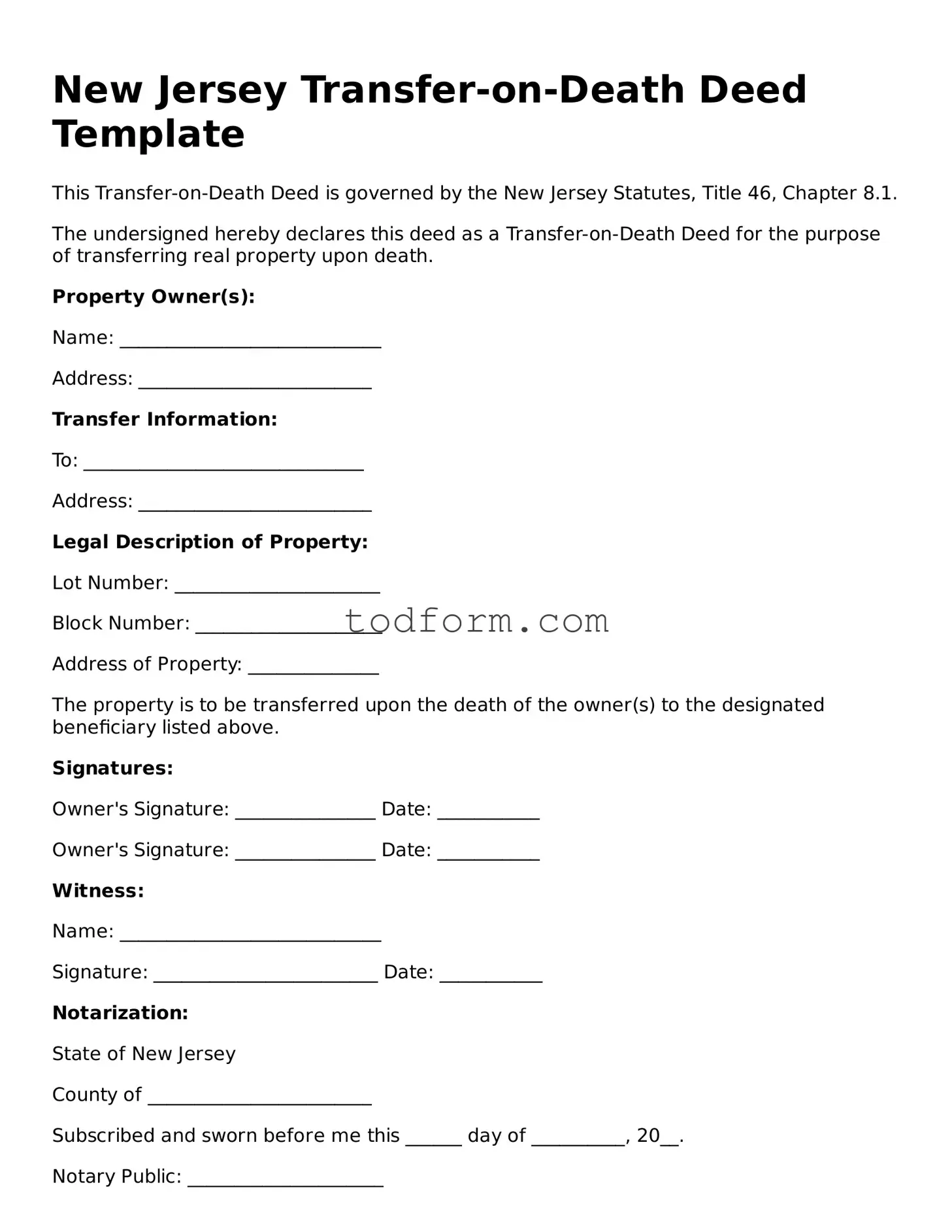The New Jersey Transfer-on-Death Deed (TODD) allows property owners to transfer real estate to beneficiaries without going through probate. This form is similar to a Living Trust, which also facilitates the transfer of assets upon death. A Living Trust allows individuals to place their assets in a trust during their lifetime, and upon their death, the assets are distributed to the beneficiaries without the need for probate. Both documents serve to streamline the transfer process and provide privacy, as they do not become part of the public record like a will would.
Another similar document is the Beneficiary Deed, which functions in a manner akin to the TODD. A Beneficiary Deed allows property owners to designate one or more beneficiaries to receive the property upon their death. Like the TODD, it avoids probate, enabling a smoother transition of ownership. However, the specifics of execution and state laws governing Beneficiary Deeds can vary, making it essential for property owners to understand local regulations.
The Quitclaim Deed is another document that shares similarities with the TODD. This type of deed transfers ownership interest in property without guaranteeing that the title is clear. While a Quitclaim Deed can be used to transfer property during the owner’s lifetime, it does not provide the same posthumous transfer benefits as a TODD. However, both documents can be used to simplify the transfer of property between family members or friends.
Another relevant document is the Will. A Will outlines how a person's assets will be distributed after their death. While a Will must go through probate, which can be time-consuming, the TODD allows for a more direct transfer of property. Both documents serve as critical components of estate planning, ensuring that an individual's wishes regarding their assets are honored.
The Power of Attorney (POA) is similar in that it allows someone to manage another person's affairs, including property, while they are still alive. However, a POA becomes invalid upon the death of the principal, while a TODD only comes into effect after death. Both documents can be essential for ensuring that property is managed according to the property owner's wishes, but they operate at different times in the ownership lifecycle.
The Life Estate Deed also bears resemblance to the TODD. A Life Estate Deed grants an individual the right to use and benefit from a property during their lifetime, with the property passing to another party upon their death. Like the TODD, it avoids probate but creates a more complex ownership structure. The life tenant retains certain rights, while the remainderman receives the property after the life tenant's death.
The Joint Tenancy with Right of Survivorship is another document that serves a similar purpose. In this arrangement, two or more people own property together, and upon the death of one owner, the surviving owner(s) automatically inherit the deceased owner's share. This method, like the TODD, bypasses probate. However, it requires the joint owners to be in agreement about the property during their lifetime.
The Revocable Trust is closely related to the TODD as well. This document allows individuals to place their assets in a trust, which they can modify or revoke during their lifetime. Upon death, the assets in the trust are distributed according to the trust's terms, avoiding probate. Both the Revocable Trust and the TODD provide a way to transfer property outside of the probate process, but the Revocable Trust offers more comprehensive management of assets during the grantor's lifetime.
The Affidavit of Heirship is another document that can be relevant in estate planning. This legal document establishes the heirs of a deceased person and can help facilitate the transfer of property. While it does not directly transfer property like the TODD, it can be used in conjunction with it to clarify ownership and simplify the transfer process after death.
Lastly, the Assignment of Interest can be compared to the TODD. This document allows a property owner to assign their interest in a property to another person. While it can be used during the owner's lifetime, it does not automatically transfer ownership upon death like the TODD does. However, both documents can be used to manage property interests and facilitate transfers, making them valuable tools in estate planning.
